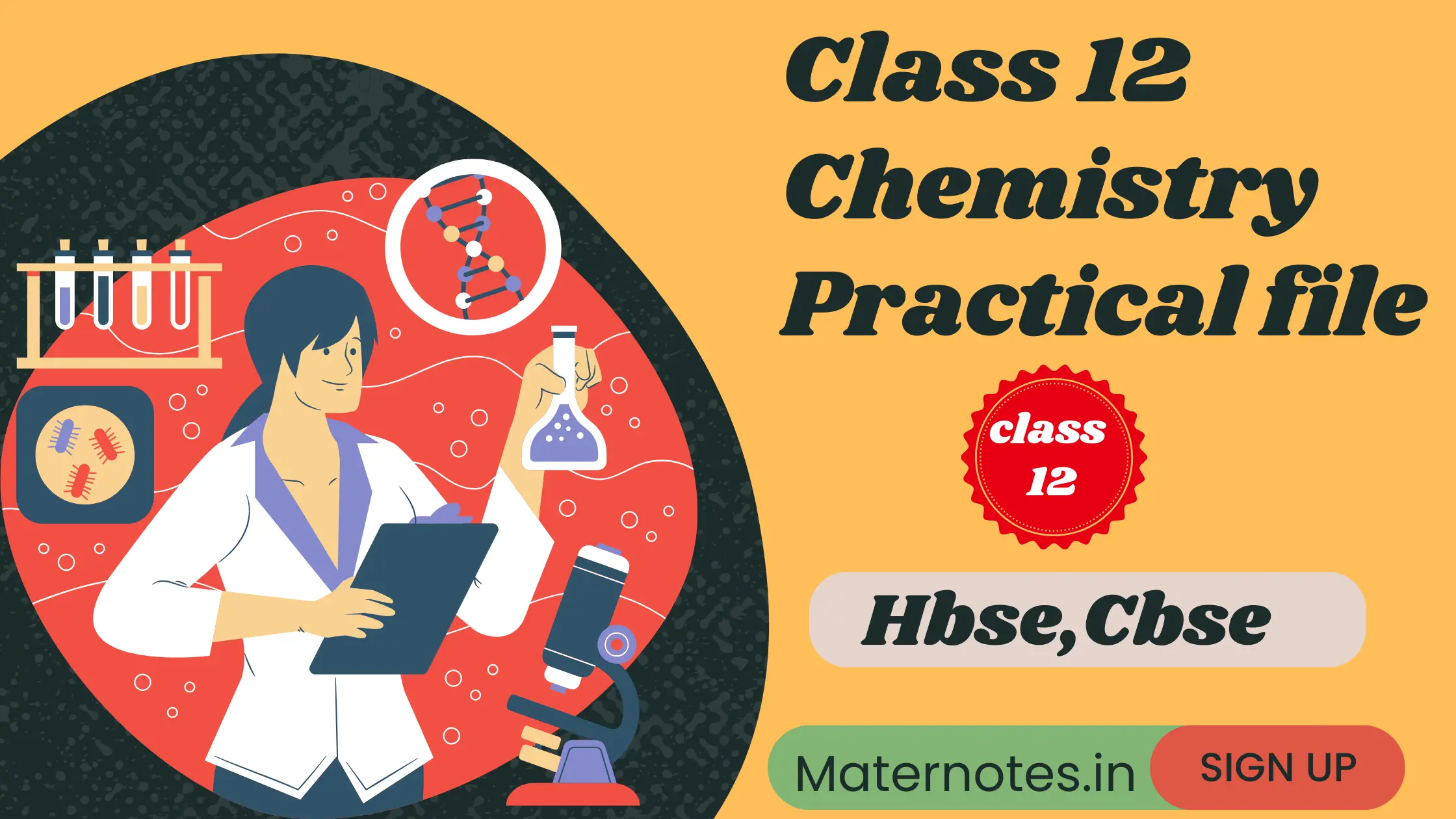Welcome to Master Notes, your academic companion for classes 9 to 12. Today, we embark on a journey through the intricacies of “Class 12 Chemistry Practical Files,” demystifying the art and science behind these crucial components of your chemistry curriculum. Let’s delve into the significance, structure, and strategies that will empower you to navigate the practical world of chemistry with confidence.
Table of Contents
Detail
Class : 12th
Subject : Chemistry
Material : Practical

Class 12 Chemistry Practical File Experiments
- A. Surface Chemistry
(a) Preparation of one lyophilic and one lyophobic sol
Lyophilic sol – starch, egg albumin and gum - Lyophobic sol – aluminium hydroxide, ferric hydroxide, arsenous sulphide.
- (b) Dialysis of sol – prepared in (a) above.
(c) Study of the role of emulsifying agents in stabilising the emulsion of different oils.
B. Chemical Kinetics
(a) Effect of concentration and temperature on the rate of reaction between Sodium Thiosulphate and Hydrochloric acid.
(b) Study of reaction rates of any one of the following:
(i) Reaction of Iodide ion with Hydrogen Peroxide at room temperature using different concentrations of Iodide ions.
(ii) Reaction between Potassium Iodate (KIO3) and Sodium Sulphite: (Na2SO3) using starch solution as an indicator (clock reaction).
C. Thermochemistry
Any one of the following experiments
(a) Enthalpy of dissolution of Copper Sulphate or Potassium Nitrate.
(b) Enthalpy of neutralisation of strong acid (HCI) and strong base (NaOH).
(c) Determination of enthalpy change during interaction (Hydrogen bond formation) between Acetone and Chloroform.
D. Electrochemistry
Variation of cell potential in Zn/Zn2+|| Cu2+/Cu with change in concentration of electrolytes (CuSO4 or ZnSO4) at room temperature.
E. Chromatography
(a) Separation of pigments from extracts of leaves and flowers by paper chromatography and determination of Rf values.
(b) Separation of constituents present in an inorganic mixture containing two cations only (constituents having a large difference in Rf values to be provided).
F. Preparation of inorganic compounds
Preparation of double salt of Ferrous Ammonium Sulphate or Potash Alum.
Preparation of Potassium Ferric Oxalate. - G. Preparation of organic compounds
Preparation of any one of the following compounds
i) Acetanilide ii) Di-benzalAcetone iii) p-Nitroacetanilide iv) Aniline Yellow or 2-Naphthol Aniline Dye. - H. Tests for the functional groups present in organic compounds:
Unsaturation, alcoholic, phenolic, aldehydic, ketonic, carboxylic and amino (Primary) groups.
I. Characteristic tests of carbohydrates, fats and proteins in pure samples and their detection in given foodstuffs.
J. Determination of concentration/molarity of KMnO4 solution by titrating it against a standard solution of:
(a) Oxalic acid
(b) Ferrous Ammonium Sulphate - (Students will be required to prepare standard solutions by weighing themselves).
- K. Qualitative analysis
Determination of one anion and one cation in a given salt
Cation:
Pb2+, Cu2+ As3+, Aℓ3+, Fe3+, Mn2+, Zn2+, Ni2+, Ca2+, Sr2+, Ba2+, Mg2+, NH2+ - Anions:
- (CO3)2-, S2-, (SO3)2-, (NO2)–, (SO4)2-, Cℓ–, Br–, I–, (PO4)3-, (C2O4)2-, CH3COO– , NO3–
- (Note: Insoluble salts excluded)
Share Box
Structure of Class 12 Chemistry Practical Files: Decoding the Components
Title Page
Your journey begins with the title page—a snapshot of what lies within your practical file. Class 12 students learn to present information concisely, including the experiment title, date, and their name.
Aim and Objective
Every experiment has a purpose. Class 12 Chemistry Practical Files require a clear articulation of the aim and objectives, defining what you intend to achieve through each experiment.
Apparatus and Materials
Precision matters. Class 12 students list the apparatus and materials used, showcasing an understanding of the tools required for each experiment. chemistry practical file class 12,class 12 chemistry practical file
Procedure
Detailing the steps is crucial. Class 12 Chemistry Practical Files provide a step-by-step guide, enabling someone else to replicate your experiment successfully.
Observations and Data
Accurate observations are the backbone. Class 12 students meticulously record data, be it measurements, color changes, or any other relevant observations during the experiment.
Calculations
Class 12 Chemistry Practical Files often involve numerical aspects. This section demonstrates your ability to process data, perform calculations, and derive meaningful results.
Results and Discussion
Interpretation is key. Class 12 students analyze their results, linking them back to theoretical concepts. Discussions delve into the significance of findings and potential sources of error.chemistry practical file class 12,class 12 chemistry practical file
Conclusion
Every experiment has a conclusion. Class 12 Chemistry Practical Files encapsulate the essence of your findings, tying together the purpose, observations, and outcomes.
Sources of Error and Precautions
Class 12 students showcase scientific rigor by identifying potential sources of error and outlining precautions taken during the experiment to ensure accuracy.
Graphs and Diagrams
Visual representation adds depth. Class 12 Chemistry Practical Files often include graphs, tables, and diagrams, providing a visual dimension to your observations and results.
References
Acknowledging sources is a scientific ethic. Class 12 students cite references, acknowledging the work of others and maintaining academic integrity.





Thank you for sharing with us, I believe this website really stands out : D.
You made several fine points there. I did a search on the theme and found nearly all people will go along with with your blog.
You are my inhalation, I have few web logs and sometimes run out from to post .
I truly appreciate your piece of work, Great post.
At this time it looks like BlogEngine is the preferred blogging platform available right now. (from what I’ve read) Is that what you are using on your blog?